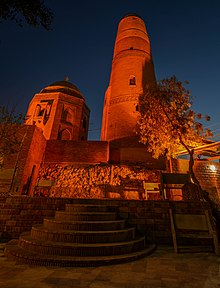| This article needs additional citations for verification. Please help improve this article by adding citations to reliable sources. Unsourced material may be challenged and removed. Find sources: "Masum Shah" – news · newspapers · books · scholar · JSTOR (October 2014) (Learn how and when to remove this message) |

Mir Muhammad Masoom Shah Bakhri, also known as Syed Nizamuddin Mir Muhammad Masoom Shah, was a sixteenth-century Sindhi Muslim historian from Bakhar, Sindh (modern-day Pakistan). He is known for writing a history of Sindh, Tarikh i Sind (also known as, Tarikh i Masumi, after the author), published in ca. 1600. He was also a trusted lieutenant of the Mughal emperor Akbar. In around 1595, he led Akbar's army in a battle against the Panni Afghans stronghold of Sibi in northwest Quetta, resulting in Baluchistan being annexed into the Mughal empire. Subsequently, in 1598, he was appointed the governor of Sind and Sibi by Akbar.
Minaret of Masum Shah

The minaret of Ali Abuzar is the most conspicuous structure of Sukkur town, dating back to 1607 during the Mughal Empire in the Indian subcontinent. Masum Shah was the governor of Mughal Emperor Akbar who appointed him as the Nawab of Sukkur. The minaret was built in about 1607 the monument, built of red brick, is more or less conical in shape, slightly off the perpendicular and surmounted by a dome to which an internal stone staircase gives an access. It is about 26 metres in circumference and has 84 steps to the top. It is about 31 metres feet in height and can be seen from miles away. This minaret is believed to have been used as a watch tower. The courtyard around the minaret is the cemetery where Mir Mausum Shah and his family members are buried.
Family and offspring of Nizam-ud-Din Mir Muhammad Masum Shah still lives in old Sukkur where he lived during his ruling time. The minaret and its surroundings are still under power of Masumi Family even though Government of Pakistan has taken the management control of this historical site.
References
- Mehta, Jaswant Lal (1979). Advanced Study in the History of Medieval India, Volume 1. Sterling publishers. p. 24. ISBN 9788120706170.
- Mehta, Jl. Advanced Study in the History of Medieval India. Sterling Publishers Pvt. ISBN 9788120710153.
- Mehta, Jaswant Lal (1986). Advanced Study in the History of Medieval India, Volume 2. Sterling Publishers. p. 258. ISBN 9788120710153.
- Marri, Mir Khuda Bakhsh (1964). The Balochis through centuries; history versus legend. Quetta. p. 35.
{{cite book}}: CS1 maint: location missing publisher (link)
External links
- Towering relics of Sukkur, The Express Tribune
This Sindh location article is a stub. You can help Misplaced Pages by expanding it. |